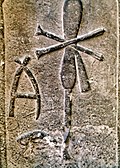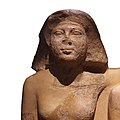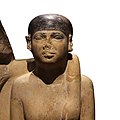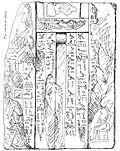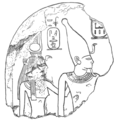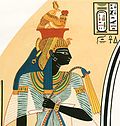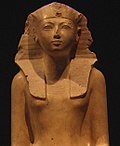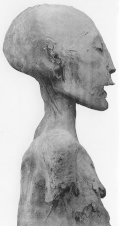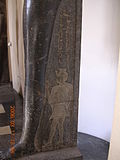Background




The Pharaoh's wives played an important role both in public and private life, and would be a source of political and religious power. [1] Pharaohs usually had many different wives, so that a successor could be guaranteed to succeed him. If a queen succeeded in producing an heir that inherited the throne, she would reach a position of great honour as King's Mother and may be able to rule Egypt on behalf of her son as regent if he was underage. [1] While there are many known cases of kings marrying their sisters, there were also wives of non–royal birth, such as Tiye and Nefertiti. [2] Kings such as Amenhotep III and Ramesses II are known to have married some of their daughters, though it is possible these marriages were symbolic and ceremonial rather than incestuous. [3] Apart from the chief consort, the Pharaoh would have many wives in the harem, who could be foreign–born princesses or lower–ranking Egyptian women who had little impact on politics. [4]
While women did occasionally rule as Pharaohs, they generally did not rule while married except during the Ptolemaic period. Thus, male consorts never existed during the time of the native Egyptian royal dynasties, and only Berenice IV and Cleopatra VII are listed as having male consorts who did not rule as Pharaohs.
List of female rulers and co–rulers
Most Queens included on this page did not rule as Pharaohs. However, some did rule in their own right following the deaths of their husbands. Four Queens from the Native Egyptian dynasties are known for certain to have ruled as Female Pharaohs:
- Sobekneferu (c. 1806–1802 BC) (Possibly wife of Amenemhat IV)
- Hatshepsut (c. 1479–1458 BC) (Wife of Thutmose II)
- Neferneferuaten (c. 1334–1332 BC) (Wife of either Akhenaten or Smenkhare depending on her identity)
- Twosret (c. 1191–1189 BC) (Wife of Seti II)
There has also been some debate on whether certain Queen regents such as Neithotep, Merneith, Khentkaus I and Khentkaus II did rule as Female Pharaohs or not. However, there is yet to be any concrete evidence that they did. The legendary Queen Nitocris was supposedly a Pharaoh at the end of the Sixth Dynasty, but no archeological evidence supports her existence.
The Ptolemaic Dynasty implemented a policy of co–rule between spouses. Therefore, many Queens from this dynasty are not listed as consorts as they were co–rulers of Egypt while married to their husbands.
Women who were dating their regnal years in royal protocols (alongside their co–rulers or independently) and thus were unquestionable Pharaohs were: [5]
- Cleopatra II (170–164, 163–127, 124–116 BC) initially Queen consort, then Queen regnant alongside her brother–husband Ptolemy VI, her younger brother (later husband) Ptolemy VIII, her son Ptolemy VII, her daughter Cleopatra III and briefly her grandson Ptolemy IX. She was the sole ruler of Egypt from 131 to 127 BC, the first woman to do so since Twosret over a millennium before. She was also first known Ptolemaic queen included in dating protocols as ruler alongside her spouses, making her unquestionably queen in her own right.
- Cleopatra III (142–131, 127–101 BC) ruled alongside her uncle–husband Ptolemy VIII, her mother Cleopatra II, her eldest son Ptolemy IX, her daughter Cleopatra IV and her second eldest son Ptolemy X.
- Berenice III (101–88, 81–80 BC) ruled alongside her uncle–husband Ptolemy X, her father Ptolemy IX and her brother–husband Ptolemy XI. She briefly ruled by herself from 81 BC to 80 BC before she was murdered on the orders of Ptolemy XI.
- Cleopatra V (79–68 BC) ruled alongside her husband Ptolemy XII.
- Cleopatra VI (58–57 BC) ruled alongside her sister Berenice IV. However, some historians theorise she may actually be the same person as Cleopatra V.
- Berenice IV (58–55 BC) briefly ruled alongside her sister (or possibly mother) Cleopatra VI, but otherwise spent most of her reign as the sole ruler of Egypt.
- Cleopatra VII (51–30 BC) ruled alongside her brother–husband Ptolemy XIII, her second brother–husband Ptolemy XIV and her son Ptolemy XV.
Evidence of co–rulership in early dynasty is ambiguous. List of Ptolemaic queens who could be co–rulers with their husband includes:
- Arsinoe II (c. 277–270 BC) possibly [5] ruled alongside her brother–husband Ptolemy II. She is considered Pharaoh by Sally Ann Ashton. [6]
- Berenice II (c. 244–222 BC) possibly [a] ruled alongside her husband Ptolemy III.
- Arsinoe III (220–204 BC) possibly [b] ruled alongside her brother–husband Ptolemy IV.
- Cleopatra I (193–176 BC) possibly [c] ruled alongside her husband Ptolemy V and as a regent [d] on behalf of her son Ptolemy VI.
The claimant queen of Egypt Arsinoe IV (48–47 BC) declared herself Pharaoh in opposition to her sister Cleopatra VII.
List of regents
Occasionally when the new Pharaoh was too young to rule, his mother or step–mother would rule temporarily as a regent on his behalf. Because they did not hold the title of 'King' during their time in power, they are generally not included on Lists of Pharaohs. The following Queens are likely to have ruled as regents:
- Neithhotep possibly ruled on behalf of her son Hor–Aha (c. 3050 BC)
- Merneith ruled on behalf of her son Den (c. 2970 BC)
- Nimaathap possibly ruled on behalf of her son Djoser (c. 2670 BC)
- Khentkaus I likely ruled as a regent, but her son or sons are unknown.
- Khentkaus II possibly ruled as a regent for one of her sons (Neferefre or Nyuserre Ini).
- Iput I possibly ruled as a regent for her son Pepi I (c. 2332 BC)
- Ankhesenpepi II ruled as a regent for her son Pepi II (c. 2278 BC)
- Ahhotep I ruled as a regent for her son Ahmose I (c. 1550 BC)
- Ahmose–Nefertari ruled as a regent for her son Amenhotep I (c. 1541 BC)
- Hatshepsut initially ruled as a regent for her step–son Thutmose III (c. 1479 BC) before becoming Pharaoh and co–ruler.
- Mutemwiya ruled as a regent for her son Amenhotep III (c. 1388 BC)
- Twosret ruled as a regent for Siptah who could be her step–son (c. 1197 BC)



